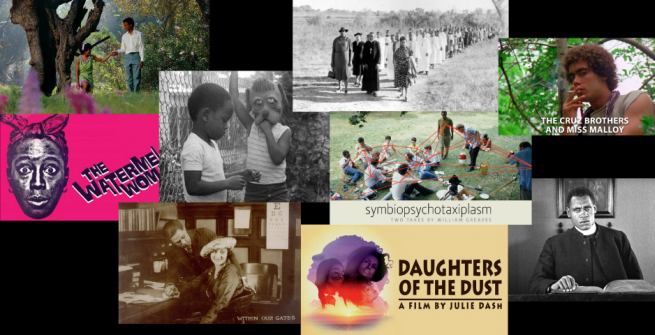For many years it was hard to find and watch many classic and influential films by African-American directors: they were not widely distributed, they were not released on home video, or they were thought to be lost. But today through the efforts of cinephiles and film restorers to bring these films to a wider audience, along with access to streaming services and DVDs, it is possible to travel through cinematic history and experience these seminal films for free with your library card.
Oscar Micheaux started directing independent films during a time when African-Americans were shut out from creative roles at the major studios. Starting as a novelist he quickly transitioned to writing, directing, and producing his own films. Despite the tremendous obstacles at the time he managed to create independent feature-length films in the United States from 1919 to1948 and he is considered the first African-American director of a feature film. You can stream many of his films on Kanopy including Body and Soul which marked Paul Robeson’s film debut, and Within Our Gates which is most likely the first surviving feature film directed by an African-American. Within Our Gates is also often considered partly a response to the racist Birth of a Nation and showed the violence Black Americans faced in the Jim Crow South.
Spencer Williams, Jr. worked as an actor in studio films and television, but he also wrote and directed his own independent movies. The Blood of Jesus was his second film and he shot it in Texas with a local cast and a budget of only $5,000. The story centers on the visions of a woman who after being accidentally shot by her husband is torn between heaven and hell. Its unique vision and its gospel soundtrack have engaged audiences for years.
William Greaves was primarily known for being a documentary filmmaker, but in 1968 he shot the innovative experimental film Symbiopsychotaxiplasm (released in 1971). In this film, viewers watch behind the scenes footage of Greaves and his crew as they supposedly make a feature entitled Over the Cliff, but as the documentary progresses it becomes increasingly harder to tell what is fact and what is fiction. Symbiopsychotaxiplasm asks question after question about how much truth a film can show and it has inspired filmmakers such as Steven Soderbergh and Ephraim Asili.
In the late 1960s Gordon Parks was already a world-famous photographer and author when he directed the adaptation of his novel The Learning Tree. This film is considered the first feature film directed by an African-American director from a major studio (Warner Bros.) and Parks also wrote and produced it. Although not achieving the blockbuster success of Parks’ follow-up film Shaft, The Learning Tree was praised for its depiction of a young man coming of age in a racist Kansas society. Recently, a DVD edition was released by the Criterion Collection which includes documentaries about the making of the film.
Charles Burnett grew up in Watts and was a key figure in the L.A. Rebellion movement, a Black independent film movement that grew out of UCLA in the 1970s. His master’s thesis for UCLA Film School was Killer of Sheep. Widely considered a masterpiece and added to the Library of Congress’ National Film Registry, it depicts a series of vignettes in the life of Stan, a slaughterhouse worker living in Watts with his family. Praised for its realism and visual poetry it was shown at venues such as the Whitney Museum in New York City in 1978 but did not receive a general release due to music rights issues. Decades later the music rights were secured for the film and it was finally able to be released.
Kathleen Collins grew up on the East Coast, attended Skidmore and Harvard, was active in the Student Nonviolent Coordinating Committee in the 1960s, and had an important career as an academic and writer. While teaching at the City University of New York she wrote and directed her first movie, the 49-minute short film The Cruz Brothers and Miss Malloy (1980). Based on a Henry H. Roth story, the film follows three Puerto Rican brothers who help restore an elderly Irish woman’s Victorian home. Two years later in 1982, she directed what is considered the first feature film by an African-American woman, Losing Ground (unfortunately not currently available on DVD or library streaming services). Sadly, Collins was only able to direct two films before her death in 1988 at the young age of 46.
Julie Dash, like Charles Burnett, attended UCLA Film School and was part of the L.A. Rebellion film movement in the 1970s and 80s. Her 1991 film Daughters of the Dust depicts a North Carolina Gullah community in 1902 during a time when many in the community were leaving for outside opportunities. It is widely considered a masterpiece and was added to the Library of Congress’ National Film Registry. In 2016 it gained new viewers when it was one of the primary visual inspirations for Beyoncé: Lemonade.
Cheryl Dunye was born in Liberia and grew up in Philadelphia. She began making short films in the 1990s that she called Dunyementaries which combined narrative and documentary elements. Her first feature film The Watermelon Woman is considered to be the first film by and about a black lesbian. In the film, Dunye plays a version of herself, an aspiring filmmaker who becomes intrigued by a black actress from the early days of Hollywood, Fae Richards, who was usually uncredited and put into stereotypical roles. Dunye worked with artist Zoe Leonard in order to create a photo archive for the fictional actress Fae Richards and used the film as a way to imaginatively fill in the gaps of what we don’t know about black actresses in the early decades of Hollywood.









